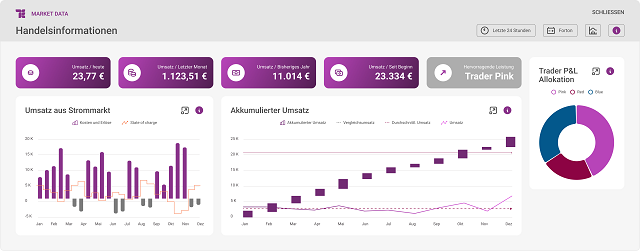As in South Africa and many other countries around the world, Tesvolt reports from Berlin that in Germany too, distribution grid operators are receiving many requests to connect large-scale energy storage systems to the medium- and high-voltage grid. This has been noted by Bayernwerk Netz, Bavaria’s largest distribution system operator, and Mitnetz Strom.

Screen shot of the TESVOLT ENERGY trading dashboard.
Due to the required grid expansion measures, the waiting period for applicants is usually at least five years. Start-up TESVOLT ENERGY has found a solution that can quickly connect battery storage solutions to the utility grid. It gives commerce and industry – which usually already have a sufficiently large connection to the low-voltage grid – the previously lacking incentive to connect smaller energy storage systems of 100 kWh or more to the utility grid.
Influx of applications for grid connections
“The number of applicants that want to connect large-scale storage systems to the utility grid is continuing to rise. This is the same for the other large distribution system operators,” reports Stephan Kilz, Head of Generation Plants for Individual Customers at Mitnetz Strom, one of the largest distribution system operators in eastern Germany. “Bringing more flexibility to the utility grid using battery storage systems is important. However, this usually requires grid expansion measures, so it often takes several years before a new large-scale storage system or battery park can be connected to the utility grid.”
Bayernwerk Netz, Bavaria’s largest grid operator, similarly reports the very high number of connection requests for large-scale storage systems. For the medium- and high-voltage grid, the capacity for grid connections has already been exhausted to the extent that it will only be possible to connect storage systems of more than 300 kW in five years’ time or longer.
An incentive for smaller battery storage systems
“We urgently need much more storage capacity in the electricity grid so that renewable energy suppliers do not have to be limited in the event of strong sunlight and strong wind. Instead of building a mind-boggling number of new gas-fired power plants to make the electricity grid more flexible, we should focus on climate-friendly solutions,” says Sebastian Kratz, Managing Director of TESVOLT ENERGY. “Commercial and industrial companies have enormous potential for bringing the urgently needed flexibility to the utility grid with battery storage systems. So far, other than the big battery park operators, they have not had the opportunity to find a good trader that trades small storage capacities on the exchange. They have therefore been excluded from energy trading.”
A network of smaller storage systems
TESVOLT ENERGY is enabling commerce and industry to engage in lucrative in-front-of-the-meter energy trading for the first time. The company integrates battery storage systems of 100 kWh or more into a pool. This way, many smaller storage systems form a virtual power plant, and its capacity is traded by established traders Enspired, Entrix and The Mobility House. The prerequisite is that commercial enterprises have a grid connection point with an output of at least 50 kW. On-site planning, installation and maintenance of battery storage systems are handled by specialist partners trained and certified by TESVOLT.
A one-of-a-kind first
“We bring our traders into competition with each other. The energy trader whose trades achieve the highest revenues with the least intensive operation of the storage systems gets to manage the most battery systems in our pool,” explains Anshoo Pandey, who is heading the new company together with Sebastian Kratz. “This business model is unique on the market so far. It allows us to generate higher revenues for our customers.” Software developed by TESVOLT ENERGY ensures careful operation of the battery storage systems. TESVOLT storage systems that use this software therefore also have a 15-year performance guarantee, which far exceeds the usual market performance guarantees.
Collaboration with grid operators
“We are also open to respond to the requirements of grid operators and operate storage systems in a grid-neutral manner or in a grid-supporting manner at specific times – that is – not feeding electricity from the storage systems into the utility grid when renewables are supplying a lot of electricity. Or using our storage systems to absorb excess electricity from the utility grid,” says Kratz. “Using our software and redispatch interface, we can implement this technically straight away and are already talking to grid operators about specific timescales and restrictions for charging and discharging our battery storage systems.
“We are all driven by the goal of getting as much renewable electricity as possible into the utility grid. Climate protection is key. In the current political debate about gas and other fossil fuels, the enormous costs of climate change are often ignored.”
TESVOLT ENERGY GmbH is a software start-up based in Berlin, Germany, and a wholly owned subsidiary of battery storage specialist TESVOLT AG.
For more information visit: https://www.tesvolt-energy.com/en/